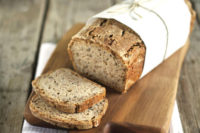Hidden Assets
New sweeteners, starches and gums help bakers and snack producers meet consumers’ demand for tasty, better-for-you products.


























When eating a favorite snack or bakery product, few people stop and consider all of the ingredients that give these products the taste and mouthfeel they enjoy. Consumers don’t care if the layer cake on their plate is moist because it’s made with a special flour formulation or that a gum blend makes the frosting smooth. Bakers and snack producers, however, do care, because their reputation and sales depend on delivering high-quality products to customers and consumers. That’s why they turn to ingredients suppliers for versatile additives like sweeteners, starches and gums when developing high-quality baked goods and snacks. Here’s a look at some of the latest offerings.
How sweet it is
A growing number of Americans are becoming more concerned about how many and what kind of sweet foods they consume daily. “Consumers are striving to limit their sugar intake, seeking sweetener alternatives perceived as healthier and moving away from artificial sweeteners, such as saccharin, aspartame and the like,” explains Patrick O’Brien, marketing manager, bakery, at National Starch Food Innovation, Bridgewater, N.J.
To help bakers and snack manufacturers develop products that satisfy consumers’ cravings for treats that are sweet, yet better-for-you, the company recently introduced Erysta Crystalline Erythritol, a bulk, natural, sugar-free sweetener that has about 0.8 times the sweetness of sugar, but only 0.2 calories per gram. The white, odorless powder can be used in conjunction with Enliten, a low-calorie Stevia sweetener introduced by Corn Products International in 2008, as well as other polyols, to create reduced-sugar or sugar-free cookies, muffins, cakes, cereal bars and other baked goods.
While Stevia continues to gain acceptance among consumers seeking natural sweeteners, it can have a lingering, sometimes bitter, aftertaste when used in certain concentrations. In fact, it was customer concerns about the difficulty of using Stevia as a sugar replacement in baked goods, snacks, desserts and other edibles that prompted St. Francis, Wis.-based Wixon, a manufacturer of seasonings, flavors, ingredients and consumer products, to add Mag-nifique for Stevia to its line of Mag-nifique flavor modifiers.
In addition to eliminating Stevia’s bitter aftertaste, the new flavor modifier has a synergistic effect that enhances Stevia in applications, says Bob Kaminski, director of Wixon’s consumer products lab. “You get more sweetness without adding more Stevia,” he says. “In product development, you can now optimize product taste and manage costs. The product is also heat-, retort- and pH-stable.”
According to Kaminski, Mag-nifique for Stevia can be used in better-for-you foods and in products for people with diabetes and food allergies, because it doesn’t significantly increase carbohydrate levels, and is free of known allergens.
Honey, which has been sweetening cakes and other foods for thousands of years, is proving to be an invaluable sweetener for bakers developing new products for the gluten-free market. “Honey plays two significant roles in gluten-free products,” says Catherine Barry, director of marketing at the National Honey Board, Firestone, Colo. “First, honey provides an exceptional natural sweetness, while maintaining a clean label. Second, and just as important, honey significantly contributes to bakery foods’ moisture, making sure they stay soft and maintain a desirable texture.”
But manufacturers of all types of baked goods and snacks are turning to this all-natural ingredient for more than just its sweetness. “[It] increases the shelf life of bakery foods through the three main factors that help maintain crumb softness: preventing moisture transfer, delaying starch recrystallization and hydrolyzing starch,” Barry says. “Liquid honey is hygroscopic and enables products to maintain their moisture content far longer than products that use dry sweeteners. Honey, by design, does not give up its water easily. With an average water activity of 0.55, honey acts as a natural humectant.”
Another enduring ingredient manufacturers use in baked goods to add all-natural sweetness—as well as moisture, texture and visual appeal—is blueberries. “With consumers reading labels before they buy a product, blueberries in the ingredient statement say ‘wholesome’ and ‘natural’ in a way that consumers understand,” says Thomas J. Payne, an industry consultant for the U.S. Highbush Blueberry Council, Richmond, Va. “The perception of blueberries as healthy ingredients has led to a surge in the popularity and sales of blueberries in all of their forms.”
Blueberries and blueberry formats in baked goods and snack products can mean the need for less sugar, high-fructose corn syrup or other sweeteners, says Payne. They’re also rich in vitamins, minerals, dietary fiber, phenolics and flavonoids, but low in fat and sodium.
These superfruits are available year-round in a variety of formats: Fresh; frozen; individually quick-frozen (IQF); pureed; concentrated; as juice; and osmotically preserved. Frozen and IQF berries can be ground directly into mixes. Blueberry concentrate adds sweetness and color to granola bars, bagels and cookies, while dried blueberries add nutrition to granola and trail mixes. And everybody’s favorite—fresh berries—add just the right sweetness and moisture to baked goods.
In the thick of it
Like sweeteners, starchy foods are considered by many consumers to be products that should be eaten sparingly. Potatoes, especially, get a bad rap for their high concentration of carbohydrates. No wonder few people would consider potato starch an ingredient in a growing number of better-for-you foods.
Emsland Group’s new Emfix potato starches, for instance, are genetically modified organism (GMO)-free and have improved emulsification properties that provide vital structure for baked goods, particularly cakes and muffins. These properties make the starches excellent replacements for eggs in bakery mixes, says Mel Festejo, chief operating officer at American Key Food Products, Closter, N.J., a U.S. distributor of potato starches and other potato derivatives from the German manufacturer of refined starches, proteins, fibers, potato flakes and potato granulates.
“While egg replacement is often driven by cost or economic factors, it is also necessary to address the requirements of a growing segment of special dietary products,” Fetejo explains. “The inherent emulsification properties of Emfix starches also help in developing low-fat formulations and those requiring a reduction of emulsifiers.”
Penford Food Ingredients’ PenFibe RS potato-based resistant starch also was developed for use in products that address consumers’ health and wellness needs. It can be used to boost fiber content as well as replace high-calorie content, in such foods as breads, biscuits, snacks and gluten-free foods. “These benefits allow [our] customers to position their product to various consumer markets, such as weight management, sports, kids’ nutrition and digestive health,” says Dr. Ibrahim Abbas, senior R&D manager at the Centennial, Colo.-based manufacturer of specialty, naturally-based ingredient systems for food and other products.
Due to its low water-holding capacity, PenFibe RS can be used in bakery items with minimal reformulation. In some products, for instance, it can even be used as a 1:1 replacement for flour. Furthermore, because of PenFibe RS’s high fiber recovery, food processors don’t need to increase its usage to target specific fiber content, Abbas adds, which means a lower cost-in-use compared to other fibers on the market.
Keeping it together
With raw ingredient costs rapidly rising, it’s understandable that bakers and snack producers are seeking viable alternatives to these items to keep their costs in check, while still delivering high-quality products.
TIC Gums, White Marsh, Md., recently introduced a product line for panning and sealing nuts and candy. TicaPAN Coating Systems—TicaPAN 311, TicaPAN Quick Crunch and TicaPAN Seal—offer food manufacturers low-cost, non-gum-arabic-based systems that exhibit the same or better functionality as traditional gum arabic, but at 20% less cost, says marketing manager Harold Nicoll.
TicaPAN Coating Systems are used for binding and strengthening sugar and sugar-alcohol shells on panned confections and items containing oxygen-sensitive oils. They also can be used to replace sugar-based syrups and honey in applications including granola and energy bars.
According to Nicoll, TicaPAN 311 is a drop-in, 1:1 replacement for gum arabic. It acts as a binder for sugar and sugar-alcohol syrups used in hard and soft confections, and has crystallization, binding and viscosity properties comparable to those of gum arabic. TicaPAN Quick Crunch dries faster than gum arabic and gives a crunch shell and texture to finished confections.
TicaPAN Seal is a film former that serves as an oil and oxygen barrier for panned nuts, chocolate candies and other confections with oil-containing centers.
Gum Technology, Tucson, Ariz., also has developed alternative systems for use in snack foods and baked goods in response to the rising price of gums, particularly guar gum.
According to marketing director Janelle Litel, the company’s new Coyote brand GumPlete line combines the best of gums and starches to create a stabilizing system that reduces overall usage levels, helps maintain system integrity and creates a cleaner flavor release with a great mouthfeel. Of the six systems introduced in April 2011, GumPlete SCC-CN-301 was designed to improve frostings and icings by creating viscosity, holding aeration and providing texture with smooth mouthfeel. It also improves freeze and thaw stability and prevents sugar bloom.
Hydro-Fi, a texturizing system introduced last year, is the result of a collaboration between Gum Technology and Fiberstar Inc., River Falls, Wis. The system features four products that combine Gum Technology’s Coyote brand hydrocolloids and Fiberstar’s Citri-Fi citrus fiber. Hydro-Fi CXA-0823, which was designed to replace eggs in baked good applications such as cakes, cupcakes and muffins, improves moisture retention and increases shelf life. It allows for up to 50% egg replacement without the need for extra emulsifiers, offers cost savings and improves texture, mouthfeel and cell structure.
While some consumers complain about the additives in the foods they buy, they might not fully understand what these ingredients are made from and how they enhance consumables. Fortunately, ingredients suppliers, bakers and snack producers understand these concerns and are continuously working together to develop new sweeteners, starches and gums to create tasty, better-for-you products.
Looking for a reprint of this article?
From high-res PDFs to custom plaques, order your copy today!



















